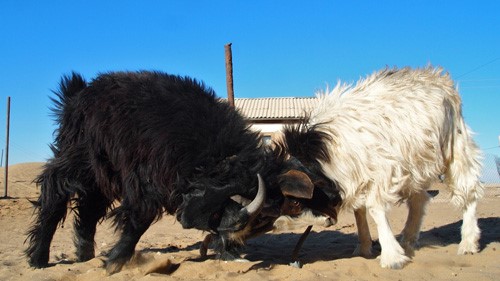Uzbek Goats
are from Uzbekistan and are used for the
production of mohair. They were developed by the
mating of predominantly white first and second generation crossbred females
with purebred white Angora males resulted in the appearance of 1-2% of black
kids.
After 4-5 years, there were
already several hundred black wool goats; they were gathered into one herd and
females were mated only to black males. Such mating produced in the first year
64% and in the second 74% of black kids; others were white, tan, grey, etc.
Later, due to positive assortative mating, it was possible to obtain 94% of
black kids.
The black goats are similar to
Don goats in such aspects as fleece structure, physical properties of wool fibers
and productivity. Uzbek goats have wool fibers longer than guard hairs, except
along the spine where the latter are very long. Their hair is not shed in
spring but wool is shed abundantly, starting from the first warm spring days
when goats pass to grass feeding.
Their wool is combed out
selectively at the time of molting and, as a rule, only once, in mid-March.
Average yields per head in collective farms vary from 280 to 440 g. While the
length and fineness of fibers depend on the level and quality of feeding, wool
yields are actually determined by the time of combing out the molting fibers.
Shedding is very rapid and 5-10 days delay in combing results in 20-40% loss
irrespective of age. The extreme limits are 6 and 12 cm in females and even
more in males. Fiber diameter is within the range 15-24 µm; the average for
females is 19 and for males 22 µm. In the young, wool is 1-2 µm finer than in
adults.
The state farm Baisun in
Namangan region of Uzbeckistan has a goat herd of 10,000 head and is considered
one of the best enterprises for raising black wool goats. Average wool yields
are 450 g from females, 700 g from males and 600 g from castrates. Wool goat
husbandry in this state farm is very profitable and cost-effective.
